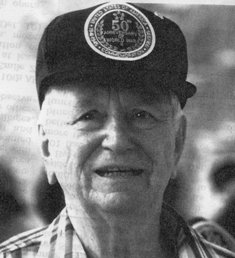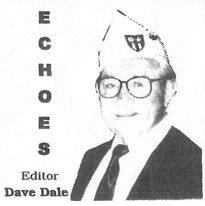The China-Burma-India Veterans Association was founded in Milwaukee, WI in 1948 as the only
veterans organization representing an entire Theater of Operations as opposed to those founded by various
units (e.g. The Hump Pilots Assoc., The Flying Tigers of the 14th Air Force, etc.).
The CBIVA closed its books in 2005 and contributed its assets to the World War II Museum in New Orleans and
the Admiral Nimitz Museum in Fredericksburg, TX.
From its birth, the organization had a quarterly publication, CBIVA Sound-off,
devoted to publicizing the activities of units being formed throughout the United States.
When I (David Dale) became editor in 1981, the organization had a healthy treasury and its leadership
approved an enlargement of the magazine's size. The largest issue had 80 pages but ease of production
called for a smaller size and the norm became 64 pages. With lots of space to fill, the local units,
called "bashas" began to send longer articles and photos to help grow their membership.
(A basha was an Indian building constructed of bamboo siding and straw and thatch roofing and was the
dwelling many CBIers were housed in.)
 Lt. Col. Joseph B. Schupe (USA Ret.)
Lt. Col. Joseph B. Schupe (USA Ret.)
|
Lt. Col. Joseph B. Shupe (USA Ret.) saw the expansion of Sound-off
as an opportunity to research and record the histories of many CBI units which contributed to the Theater's
unique role in the Second World War. Joe's articles cover the broad scope of the many units of the U.S. Army
and Air Corps serving in CBI. The "Addendum" has been inspired by the articles submitted by CBIers telling
their personal or specific unit's contribution to the war in the CBI Theater.
We have collected the articles we deem to be the best in the 52-year history of
The CBIVA Sound-off, and compiled them into a book.
The prime writer was Lt. Col. Joe Shupe of Springfield, VA, a suburb of Washington, D.C.
He gleaned his facts for his articles from the military archives to which he had access.
CBI veterans always referred to the CBITO as "The Forgotten Theater." A more apt title might be "The Unknown
Theater" because even many World War II veterans were ignorant of our presence in Asia at the time.
This collection of histories of the various U.S. military arms in CBI was was assembled for military museums
which we felt might be disinterested in the CBIVA activities but might appreciate 200-plus pages of the histories
of outfits posted to this distant and God-forsaken area of the world (to us G.I.'s).
We hope you enjoy and excuse the amateur production. We produced several of these books. Had we realized
the number of ink cartridges used, and mistakes made, etc. we would have considered a professional printing
establishment.
David Dale, Editor
 The book is presented here in eleven separate PDF document files of approximately
five megabytes (5MB) each, identified as SECTION 1 through SECTION 11.
Adobe Reader is required to view these files.
All eleven sections are contained in a ZIP file of approximately 53MB identified as ALL SECTIONS.
The book is presented here in eleven separate PDF document files of approximately
five megabytes (5MB) each, identified as SECTION 1 through SECTION 11.
Adobe Reader is required to view these files.
All eleven sections are contained in a ZIP file of approximately 53MB identified as ALL SECTIONS.
PDF files created by David Hanneke (Dave Dale's grandson).
Click to open the desired section and view online - or - right-click and select "Save Target As..."
to save it to your computer.
Allow time for download to complete.




 The book is presented here in eleven separate PDF document files of approximately
five megabytes (5MB) each, identified as SECTION 1 through SECTION 11.
Adobe Reader is required to view these files.
All eleven sections are contained in a ZIP file of approximately 53MB identified as ALL SECTIONS.
The book is presented here in eleven separate PDF document files of approximately
five megabytes (5MB) each, identified as SECTION 1 through SECTION 11.
Adobe Reader is required to view these files.
All eleven sections are contained in a ZIP file of approximately 53MB identified as ALL SECTIONS.
